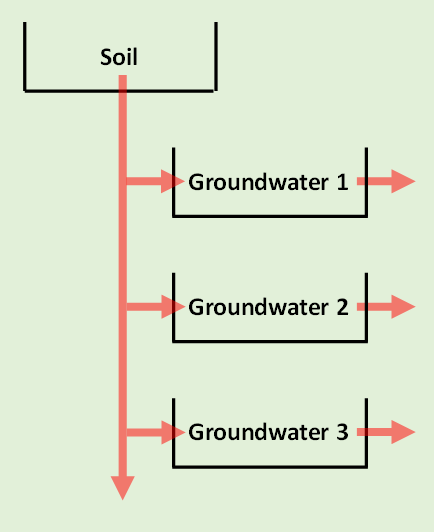Download PDF
Download page Linear Reservoir Model.
Linear Reservoir Model
Basic Concepts and Equations
As implied by its name, the Linear Reservoir baseflow method uses one to three linear reservoirs (layers) to simulate the recession of baseflow after a storm event.
Unlike the other baseflow methods contained within HEC-HMS, this method is guaranteed to conserve mass (i.e., the baseflow volume cannot exceed precipitation losses).
The volume of infiltrated water is used as inflow to the Linear Reservoir method. Inflow can be partitioned to each layer in addition to deep aquifer recharge. As such, during periods of high infiltration, more baseflow will be generated. Conversely, during periods of little to no infiltration, less baseflow will be generated. When three groundwater reservoirs are used within this method, the system can be conceptualized as shown in the following figure.

As described within the Soil Moisture Accounting Loss Method (SMA) section, when the Linear Reservoir method is used in conjunction with the SMA infiltration method, special behavior is produced. The lateral outflow from the SMA groundwater layer 1 is connected as inflow to the Linear Reservoir groundwater layer 1. The lateral outflow from the SMA groundwater layer 2 is connected as inflow to the Linear Reservoir groundwater layer 2. The percolation out of the SMA groundwater layer 2 is connected as inflow to the Linear Reservoir groundwater layer 3. Partition fractions are not used for the Linear Reservoir groundwater 1 and 2 layers because their inflow is determined by the respective lateral outflow from the SMA groundwater layers. However, a partition fraction should be used with the Linear Reservoir groundwater layer 3 in order to define how much percolation from SMA groundwater layer 2 is lost to deep aquifer recharge how much goes towards inflow to the Linear Reservoir groundwater layer 3.
The Linear Reservoir Baseflow method can be used with any loss method; it DOES NOT require the use of the SMA loss method.
Required Parameters
Parameters that are required to utilize this method within HEC-HMS include the number of reservoirs/layers, the initial baseflow type and value, the partition fraction, the routing coefficient [hours], and the number of routing steps for each layer. The initial discharge type can be specified as either a discharge rate [ft3/sec or m3/sec] or a discharge rate per area [ft3/sec/mi2 or m3/sec/km2]. Using the discharge rate method is appropriate when there is observed streamflow data at the outlet of the subbasin for determining the initial flow in the channel. The discharge rate per area method is better suited when regional information is available. However, the same method must be used for specifying the initial condition for all layers. The partition fraction is used to determine the amount of inflow going to each layer. Each fraction must be greater than 0.0 and the sum of the fractions must be less than or equal to 1.0. If the sum of the fractions is less than 1.0, the remaining volume will be removed from the system (i.e. deep aquifer recharge). If the sum of the fractions is exactly equal to 1.0, then all percolation will become baseflow and there will be no deep aquifer recharge. The routing coefficient is the time constant for each layer. Similar to the estimation of parameters for the Clark unit hydrograph transform, this parameter can be estimated using measurable watershed characteristics. The number of routing steps can be used to subdivide the routing through each layer and is related to the amount of attenuation during the routing. Minimum attenuation is achieved when only one routing step is selected. Attenuation of baseflow increases as the number of steps increases.
A tutorial describing an example application of this baseflow method, including parameter estimation and calibration, can be found here: Applying the Linear Reservoir Baseflow Method.